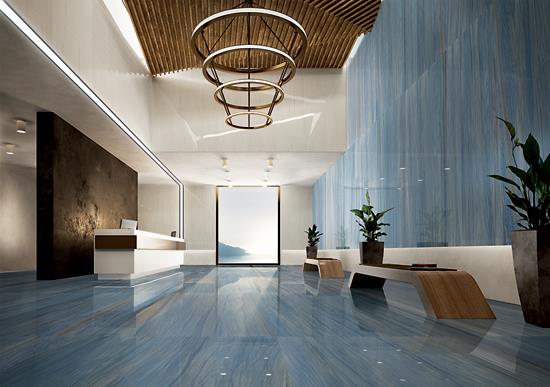Cersaie 2017: New styling and expanded end uses for ceramic products - Nov 2017
By Kemp Harr
Held every year in Bologna, Italy, the Cersaie tile show is far and away the most fashion-oriented expo in the business. Not only do the exhibits display the latest creations in manufactured tile, but most of the spaces also offer vignettes that show how great a room can look using the latest visuals in ceramics. This year’s show, held in late September, attracted over 111,000 people, up 4.7% from the previous year, to the bustling fairground with multiple buildings and over 1.6 million square feet of exhibits from 869 exhibitors.
Not only does the show attract buyers and sellers of tile from all over the world, but it also does a great job of attracting architects and interior designers, who come to see the latest product designs and learn from renowned guest speakers-like this year’s Sean Godsell from Australia and Sebastian Irarrazaval from Chile. It also attracts installers who come to learn the latest tools and installation techniques, especially the latest guidelines for large format thin tiles (which the industry now calls gauged slabs).
It’s no accident that the largest ceramic and porcelain tile show in the world is in Italy. The expo fairgrounds are a 45-minute drive from Sassuolo, where 80% of all Italian tiles are produced. Many have said that Sassuolo is to tile what Dalton, Georgia is to carpet when it comes to being the global center of the business. The Italians produce $6.4 billion worth of tile at wholesale value and only consume 15% of that domestically. And while China produces more square feet of tile, Italy is still the global leader in revenues. The average wholesale price of Italian tile sold in the U.S. today is $1.95 a square foot versus Chinese tile at $0.89 a foot.
Italian tile producers are very proud of the level of reinvestment they make every year to maintain their innovation edge in the global market. This year, producers collectively reinvested 7% of their annual revenue back into the business.
THE 2017 TILE TRENDS
It’s important to note that many of the styles introduced at Cersaie take several years to catch on in the U.S. One prime example of this is the hardwood look. Floor Focus first reported seeing tiles that look like hardwood at this show in 2008, but it was almost six years before the trend took off in the U.S., and now wood plank tiles represent one third of what’s sold in the residential tile market. This year at the show, the hardwood look was still being featured but with a little less prominence and a more refined look.
Venetian terrazzo was very popular this year. Unlike real terrazzo that contains marble chips, this product is created using inkjet printing on the surface. Several companies are varying the size of the faux aggregate for added effect.
The concrete look continues to be in demand. Using “cementina” tile over slabs can be more economical than polishing an existing slab and achieves a more upscale and consistent look. Darker colors were in vogue this year.
The textural appearance of fabrics was also prominent at this year’s show.
While the textured fabric look is not new, advancements in digital imaging and texturing allow manufacturers to create visuals today that give realistic warp and weft as well as damask looks.
The Italians continue to perfect the realistic look of stone and marble using porcelain. The veining appears to run deep into the surface, and the surface itself can be polished to a high gloss level. This results in a more resilient floor with a more sustainable footprint.
Cement tiles, also known as encaustic tile was very prominent at this year’s show. This look adds a handmade artwork flair to any space. Exhibitors were showing this in both wall and floor vignettes.
The rate of growth for floor tiles continues to keep pace with the rate of new home construction, which is being held back by the limited number of qualified tradesman in the builder sector. But fortunately for the tile market, more tile is being used up the wall, in landscaping applications and for countertops. Plus, the new thin tiles are being used as an outer skin in the furniture business and even for building cladding. In addition, here in the U.S., more and more tile is being used in rooms outside of the traditional bathroom and kitchen applications, which were the norm for many years. Based on these new diverse applications, growth within the tile industry looks very promising.
The name for large-format thin tiles continues to evolve. For several years, the industry has been using TPT, which stands for thin porcelain tiles, but earlier this year at Coverings, people started to call the product “gauged slabs.” Regardless of the name, architects from around the world are excited to have a new building material that can be used for a wide range of surface applications. One of the early inventors of large-format tiles was System Ceramics, based in Modena, Italy. The firm’s Laminam slabs are available in thicknesses that range from 3mm to 12mm and slab sizes up to 5’ wide and 10’ long. According to the new ANSI standard, panels that are thinner than 5.5mm should not be used for floor applications. Currently, no one makes this product in the U.S., but that is expected to change as the market demand picks up.
Copyright 2017 Floor Focus
